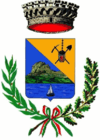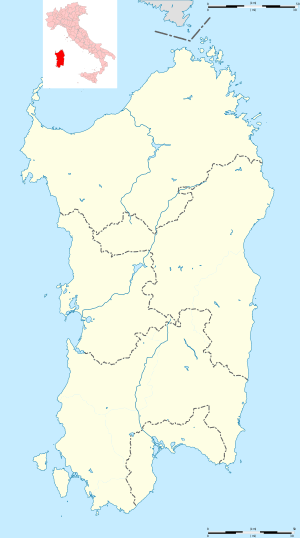Arbus, Sardinia
Arbus is a comune (municipality) in the Province of South Sardinia in the Italian region of Sardinia. Located in the southwest coast of the island, Arbus is known for its coastline, the Costa Verde, and for several archeological sites, such as the mines of Montevecchio.[2] With an area of 267 square kilometres (103 square miles), Arbus is the second largest municipality in Sardinia.
Arbus | |
|---|---|
| Comune di Arbus | |
 | |
 Coat of arms | |
Location of Arbus 
| |
 Arbus Location of Arbus in Sardinia  Arbus Arbus (Sardinia) | |
| Coordinates: 39°32′N 8°36′E | |
| Country | Italy |
| Region | Sardinia |
| Province | South Sardinia |
| Frazioni | Montevecchio, Ingurtosu, S.Antonio di Santadi, Torre dei corsari, Pistis, Porto Palma, Gutturu e Flumini, Portu maga, Sa perda marcada |
| Government | |
| • Mayor | Antonello Ecca |
| Area | |
| • Total | 269.12 km2 (103.91 sq mi) |
| Elevation | 311 m (1,020 ft) |
| Population (30 November 2017)[1] | |
| • Total | 7,340 |
| • Density | 27/km2 (71/sq mi) |
| Demonym(s) | Arburesi |
| Time zone | UTC+1 (CET) |
| • Summer (DST) | UTC+2 (CEST) |
| Postal code | 09031 |
| Dialing code | 070 |
| Website | Official website |
History
Arbus has been inhabited by man since the ancient Neolithic. It includes a mountain district which separates Medio Campidano from the sea. There are numerous tombe dei giganti (Giant graves) in the district of Capo Pecora, and in other areas of territory.
Geography and geological features
Located about 60 kilometres (37 miles) northwestward of Cagliari along the southwestern coastline, Arbus on December 31 2004 had a population of 6,895.[3] From a geological point of view, the Arbus region is dominated by low-grade metamorphics intruded, in late-Variscan times, by granodioritic and leucogranitic magmas forming the so called "Arbus igneous pluton". This pluton emplaced at 304 ± 1 Ma (U-Pb dating on zircons), along a thrust surface separating a pile of allochtonous tectonic units from the Foreland. This age, inside the correlated error, is undistinguishable from 305 ± 13 Ma obtained with Rb/Sr isochron for granodiorites. Remarkably, in the wide compositional spectrum of late-Variscan magmatism from Sardinia, the Arbus intrusives are quite distinctive. Indeed, granodiorites contain ortopyroxene and clynopyroxene in addition to ubiquitous dark mica, while leucogranites show often sub-vertical centimetric cloths of Fe-cordierite with quartz intergrowths or greenish to bluish tourmaline. Arbus is known for its coastline, known as Costa Verde. For both 2002 and 2003, the wide Arbus coasts were awarded "5 sails" by the Legambiente and Touring Club. Beaches include, from north to south, Capo Frasca, Pistis, Torre dei Corsari, Porto Palma, Babari, Funtanazza, Gutturu Flumini (Marina di Arbus), Portu Maga, Piscinas, Scivu and Capo Pecora.[4][5]
Piscinas is a sandy beach with a large dune system spanning approximately 5 square kilometres (2 square miles). Is considered one of the biggest dune systems in Europe.
Main sights
Main sights of Arbus include:
- Museum of Sardinian Knife[6]
- Monte Granatico
- Church of the Beata Vergine d'Itria
- Church of San Sebastiano
- Church of Sant'Antonio di Santadi
- Monte Arcuentu
References
- Population data from ISTAT
- Angei, Luca, Arbus tra storia e leggenda. Usanze e vita di un popolo, Cesmet, Naples 1995
- All demographics and other statistics: Italian statistical institute Istat.
- Concas, Luciano, Arbus, coste incantate e fondali da sogno, Garau, Guspini 2007
- Concas, Luciano, Arbus, le sue coste e i suoi fondali, Garau, Guspini 2003
- Museum of Sardinian Knife
Sources
- Angei, Luca, Arbus tra storia e leggenda. Usanze e vita di un popolo, Cesmet, Napoli, 1995
- Caddeo, Antonello, Arbus. Immagini e ricordi dal passato, Editar, Cagliari, 1994
- Concas, Luciano, Arbus, coste incantate e fondali da sogno, Garau, Guspini 2007
- Concas, Luciano, Arbus, le sue coste e i suoi fondali, Garau, Guspini 2003
- Mostallino Murgia, Costa Verde. Da Capo Frasca a Cala Domestica. La costa e l'interno, Zonza, Cagliari, 2005
- Piras, Aldo, Pietro Leo e Raimondo Garau. Tempi e luoghi, Garau, Guspini, 2003
External links
| Wikivoyage has a travel guide for Arbus. |
| Wikimedia Commons has media related to Arbus. |
- Official website
- Arbus.it » Village of Arbus, mines of Montevecchio and Ingurtosu, the "Green Coast" (Costa Verde)
- The Green Coast (Costa Verde) of Arbus, in English
- Tourism in Arbus
- Pro Loco di Arbus